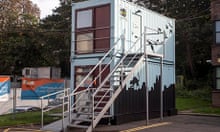Hannah Jones, 25, and her fiancé, Theo Hodnett, 27, spent months looking for a home around the picturesque market town of Ludlow in Shropshire, but couldn’t find anything in their price range. “We were facing the prospect of renting indefinitely because we couldn’t afford to buy a house of our own and prices were only going up,” says Jones, a sales and marketing assistant.
After an increasingly desperately search Hodnett, a carpenter, suggested a different approach. “His parents had just finished building their own home so he suggested that we could do it too. I’ve always wanted to build my own home. When I thought about it I started to get really excited,” Jones says.
The couple put in a planning application with Shropshire council to build a house on land given to them by Hodnett’s parents near Richards Castle, a village just down the road from Ludlow. Two years later work began on their three-bedroom house and the building was completed last summer.
In all, they spent around £125,000. They took out a £120,000 self-build mortgage with the Halifax on a two-year fixed rate of 3.9%. They had to build the property to roof height before the first mortgage payment was released, which cost them around £28,000. Self-build mortgages are typically released in four to six stages in arrears, after each stage is complete.
The finished house is now worth between £280,000 and £300,000, the couple estimate – or more than double what it cost them. They added environmentally friendly features such as a ground-source heat pump, and plan to install solar panels. Costs were kept down by doing some of the work themselves and shopping around for the materials.
“My dad and Theo worked on the house most evenings and weekends, while I helped with painting. We shopped around for things like the timber frame – the most expensive single item at £16,000,” says Jones.
“We could never have been able to buy a similar-sized house. We’ve also been incredibly lucky that there weren’t any major setbacks during the build. Now our friends are considering building their own homes, too.”
The couple took advantage of an innovative scheme run by Shropshire council which makes it easier for self-builders to secure planning permission. It is designed to boost the number of affordable homes in the region, waiving some planning restrictions if the builders agree to certain strict conditions.
But there is a catch. A clause in the planning permission stipulates that if they decide to sell, the property must be advertised as an “affordable home”, with the price capped at around 60% of its market value for the first six months on the market. At current prices, Jones and Hodnett would have to advertise their property for around £180,000. In this initial period, only a buyer with a connection to the local area would be allowed to purchase it, subject to approval from the council. However, if no one comes forward after six months, these conditions would be relaxed.
There are also restrictions over the size of the property and how it can be expanded in the future to ensure it remains affordable for future buyers. “We plan on staying for a very long time, so we weren’t worried about the restrictions on the sale price,” says Hodnett.
The couple hope to expand the property in the future. “It is already 100sq m but we hope that we will be able to add an extension, such as a conservatory, if we give the council a valid reason, such as having children.”
More than 400 people have applied to the Build Your Own Affordable Home scheme since it was originally launched by the South Shropshire borough council (now part of Shropshire council) in 2003, and 217 planning applications have been approved. Around four in five applications are from first-time buyers.
But is self-build really a solution for first-timers locked out of the property market?
Despite the popularity of television shows such as Grand Designs, appetite for self-build has slumped in recent years. This has been due to a mortgage lending drought in the wake of the credit crunch and ever-tighter planning rules, which have made it even harder to secure permission, according to Michael Holmes, spokesperson for the London Homebuilding & Renovating and Home Improvement Show.
“In the wake of the credit crunch, lenders decided that self-build mortgages were too risky and many of the bigger players pulled out. There has been some improvement since then, but it is still a very limited market,” he said.
Nationwide and Skipton building societies no longer provide self-build loans, leaving the market to smaller mutual lenders such as Bath building society. However, earlier this year Halifax, part of Lloyds banking group, reintroduced self-build mortgages after previously pulling out of the market.
Because of the restricted number of mortgages, only around 8,500 self-build homes were completed last year in England and Wales, compared to just under 12,700 in 2008, according to the National Custom & Self Build Association, a trade body – a 32% drop.
But there are hopes of a revival. Self-build is gaining support in government as a way to tackle Britain’s housing shortage. A move to expand the Help to Buy scheme to cover self-build projects has been suggested, with hopes of a launch date towards the end of this year. The existing Help to Buy scheme enables borrowers with a 5% deposit to secure a mortgage, which is guaranteed by the government.
Another government initiative could make it easier to secure planning permission. Under Right to Build, announced by the former housing minister Nick Boles in July, individuals will have the right to register their interest in building their own home and the local authority will have a duty to ensure that suitable affordable plots are made available by granting planning consents and working with local registered providers such as housing associations.
Still, for the moment at least, building your own home from scratch remains complicated and time-consuming. Instead, efforts by the government to double the number of self-build homes completed each year are focusing on custom-build, a less risky alternative. With custom-build, a developer obtains initial planning permission for a larger number of plots on a single piece of land, builds the foundations, and connects the properties to utilities such as gas and water. Buyers only need to choose the specifications for the property, such as the size, design and interior fixtures and fittings. The developer then builds it.
John Sawyer, head of custom-build at builder Igloo Regeneration, suggests these homes typically offer 10% more space for an average £10,000 less than an equivalent new-build.
Igloo is working with the Homes and Communities Agency on a pilot scheme at Trevenson Park near Pool in Cornwall to provide more than 50 custom-build homes, alongside conventional new-builds. The plots go on sale next year, and around a third of buyers who have already registered an interest in the scheme are first-timers.
“Our main market will be second and third-time buyers who are trading up and need more space. Older people in their retirement who need to down-size or move out of their current home will also make up some demand. However, first-time buyers will definitely be in the mix as well,” said Sawyer.
Getting a mortgage
Self-build mortgages aren’t like traditional home loans. Funds are usually released as specific stages of the project are reached, rather than in a lump sum at the beginning. As a result, the borrower will need enough spare cash to reach each stage before the build is re-inspected and the next tranche of funds released.
Newcastle building society currently offers an arrears payment deal through Buildstore, a specialist broker, at 5.25% for a two-year fixed rate up to 80% loan-to-value, with a £995 fee and £195 reservation fee. Meanwhile, the Melton building society has an advance payment three-year discounted rate of 4.89%, up to 75% loan-to-value. It has an application fee of £500 and completion fee of 0.50%.
The London Homebuilding & Renovating and Home Improvement Show takes place on 26-28 September at Olympia, London




Comments (…)
Sign in or create your Guardian account to join the discussion